
The Most Noble Order of the Garter is an order of chivalry founded by Edward III of England in 1348. The most senior order of knighthood in the British honours system, it is decoration outranked in precedence only by the Victoria Cross and the George Cross. The Order of the Garter is dedicated to the image and arms of Saint George, England's patron saint.

Sir Thomas Docwra was Grand Prior of the Order of Knights of the Hospital of Saint John of Jerusalem in England, and thus ranked as Premier Lay Baron of England.
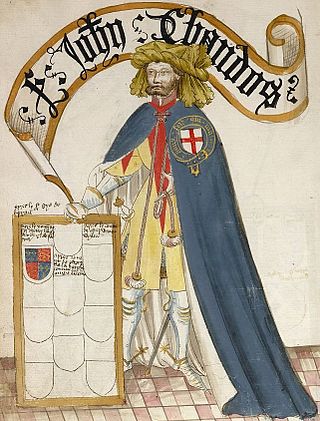
Sir John Chandos, Viscount of Saint-Sauveur in the Cotentin, Constable of Aquitaine, Seneschal of Poitou, was a medieval English knight who hailed from Radbourne Hall, Derbyshire. Chandos was a close friend of Edward the Black Prince and a founding member and 19th Knight of the Order of the Garter in 1348. Chandos was a gentleman by birth, but unlike most commanders of the day he held no inherited title of nobility.

The Royal Scots Navy was the navy of the Kingdom of Scotland from its origins in the Middle Ages until its merger with the Kingdom of England's Royal Navy per the Acts of Union 1707. There are mentions in Medieval records of fleets commanded by Scottish kings in the twelfth and thirteenth centuries. King Robert I developed naval power to counter the English in the Wars of Independence (1296–1328). The build up of naval capacity continued after the establishment of Scottish independence. In the late fourteenth century, naval warfare with England was conducted largely by hired Scots, Flemish and French merchantmen and privateers. King James I took a greater interest in naval power, establishing a shipbuilding yard at Leith and probably creating the office of Lord High Admiral.

Walter Hungerford, 1st Baron Hungerford was an English knight and landowner, from 1400 to 1414 a Member of the House of Commons, of which he became Speaker, then was an Admiral and peer.

Peter I was King of Cyprus and titular King of Jerusalem from his father's abdication on 24 November 1358 until his death in 1369. He was invested as titular Count of Tripoli in 1346. As King of Cyprus, he had some military successes, but he was unable to complete many of his plans due to internal disputes that culminated in his assassination at the hands of three of his knights.

The Battle of La Rochelle was a naval battle fought on 22 and 23 June 1372 between a Castilian fleet commanded by the Castilian Almirant Ambrosio Boccanegra and an English fleet commanded by John Hastings, 2nd Earl of Pembroke. The Castilian fleet had been sent to attack the English at La Rochelle, which was being besieged by the French. Besides Boccanegra, other Castilian commanders were Cabeza de Vaca, Fernando de Peón and Ruy Díaz de Rojas.

The King's Wardrobe, together with the Chamber, made up the personal part of medieval English government known as the King's household. Originally the room where the king's clothes, armour, and treasure were stored, the term was expanded to describe both its contents and the department of clerks who ran it. Early in the reign of Henry III the Wardrobe emerged out of the fragmentation of the Curia Regis to become the chief administrative and accounting department of the Household. The Wardrobe received regular block grants from the Exchequer for much of its history; in addition, however, the wardrobe treasure of gold and jewels enabled the king to make secret and rapid payments to fund his diplomatic and military operations, and for a time, in the 13th-14th centuries, it eclipsed the Exchequer as the chief spending department of central government.

Robert Ufford, 1st Earl of Suffolk, KG was an English peer. He was created Earl of Suffolk in 1337.
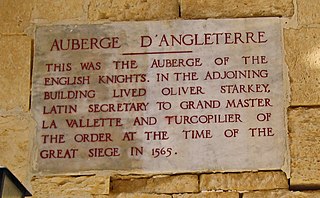
Sir Oliver Starkey (c.1523-83/86), was an English knight who lived in the 16th century. He was the only English knight present at the siege of Malta. It was wrongly assumed that he was buried in the crypt of St. John's Co-Cathedral in Valletta. The tombstone with his name on it contains only a poem written by Oliver Starkey for Grand Master Jean de La Valette. The Poem reads, in translation:'To God, Supreme, Almighty, Sacrosanct. He [La Valette] was the dread of Asia and Libya and once the guardian of Europe, after he had subdued the Turks by means of his Sacred Arms, the first one to lie buried in the grave, here in this propitious city of Valletta which he founded, worthy of eternal honour. Fra. Oliver Starkey, Pro-Turcopolier, wrote [this] poem.'

Robert Willoughby, 1st Baron Willoughby de Broke, de jure 9th Baron Latimer, KG, of Brook, near Westbury, Wiltshire, was one of the chief commanders of the royal forces of King Henry VII against the Cornish rebellion of 1497.
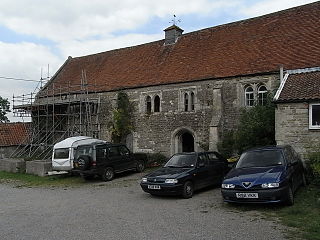
Brook in the parish of Heywood, north of Westbury in Wiltshire, England, is an historic estate. It was the seat of Robert Willoughby, 1st Baron Willoughby de Broke, KG, an important supporter of King Henry VII, whose title unusually incorporates the name of his seat, in order to differentiate him from his ancestors Barons Willoughby of Eresby, seated at Eresby Manor near Spilsby in Lincolnshire. A medieval wing survives of the mansion house known as Brook Hall, a Grade I listed building which stands near the Biss Brook.
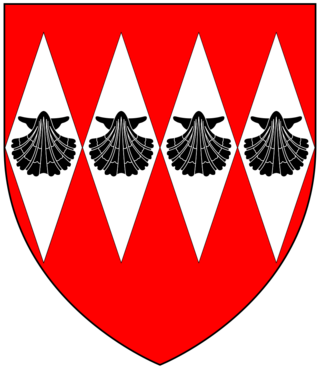
Sir Ralph Cheyne, of Brooke, in the parish of Westbury in Wiltshire, was three times a Member of Parliament for Wiltshire and was Deputy Justiciar of Ireland in 1373 and Lord Chancellor of Ireland 1383–4. He was Deputy Warden of the Cinque Ports.

St Andrew's Church in Bere Ferrers, Devon, is a parish church in the Church of England The church contains the oldest stained-glass window in Devon, dated at 600 years old. The building was probably built at various times between 1290 and 1340; it is recorded that an archpresbytery was founded here in 1333 and the north transept appears to be the earliest part of the church while the south aisle is the latest, perhaps 15th century.
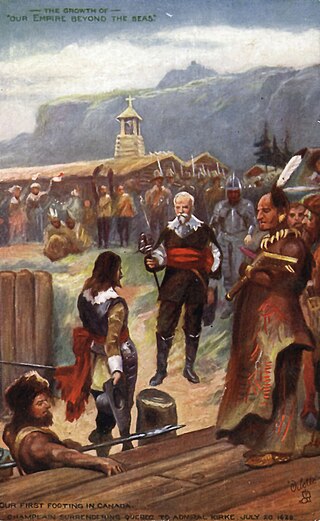
The surrender of Quebec in 1629 was the taking of Quebec City, during the Anglo-French War (1627–1629). It was achieved without battle by English privateers led by David Kirke, who had intercepted the town's supplies.

The Admiral of the North also known as Admiral of the Northern Seas and Admiral of the Northern Fleet was a senior English Navy appointment. The Admiral was chiefly responsible for the command of the navy's fleet that operated in the North Sea and off the English coast out of Yarmouth from 1294 to 1412.

The Admiral of the West, also known as Admiral of the Western Seas or Admiral of the Western Fleet, was formerly an English Navy appointment. The postholder was chiefly responsible for the command of the English navy's fleet based at Portsmouth, which operated in the English Channel, Irish Sea and Atlantic Ocean, from 1294 to 1412.

Admiral Sir John Harman was an English officer of the Royal Navy, who served first under the Commonwealth, then Charles II following the 1660 Stuart Restoration.
Robert Morley, 2nd Baron Morley, was a distinguished English administrator and military leader who fought on land and sea in wars against Scotland, Castile, and France.


















